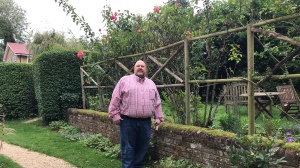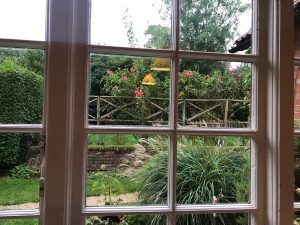Meditation at The Kilns

I have had the opportunity for a great deal of “meditation” this week regarding so many aspects of both my personal and professional life while serving as a Scholar in Residence at The Kilns. I use the word “meditation” here and put it in quotes purposely because it is in the title of an essay titled “Meditation in a Toolshed,” by C. S. Lewis. For this post I am using the definition of meditation from Oxford Languages of “a written or spoken discourse expressing considered thoughts on a subject” for “meditation.” I make that distinction because my own definition of meditation here has been based on the opening two paragraphs of “Meditation in a Toolshed”:
“I was standing today in the dark toolshed. The sun was shining outside and through the crack at the top of the door there came a sunbeam. From where I stood that beam of light, with the specks of dust floating in it, was the most striking thing in the place. Everything else was almost pitch-black. I was seeing the beam, not seeing things by it.
Then I moved, so that the beam fell on my eyes. Instantly the whole previous picture vanished. I saw no toolshed, and (above all) no beam. Instead I saw, framed in the irregular cranny at the top of the door, green leaves moving on the branches of a tree outside and beyond that, 90 odd million miles away, the sun. Looking along the beam, and looking at the beam are very different experiences.”
C.S. Lewis, “Meditation in a Toolshed” in God in the Dock (Grand Rapids: Eerdmans, 1998, pp. 212-215.)
And that’s just the beginning of the essay! The point Lewis was making is that instead of merely looking at the sunbeam and looking through it, out into the world beyond the dark of the toolshed, he sees a completely different picture. As he said, “Instead I saw, framed in the irregular cranny at the top of the door, green leaves moving on the branches of a tree outside and beyond that, 90 odd million miles away, the sun” (Lewis, p. 212). There is a difference between simply looking at something or experiencing it. We must use our experiences, just as Lewis used his toolshed experience to see something greater. Without this deeper meditation the experience would be lost on us. I call this being the “Deer In The Headlights.”

This is why it was so important for me to be at The Kilns as a Scholar in Residence. I felt the need to live through (along) this incredible place that C. S. Lewis lived, meditated, and wrote as opposed to just looking at it. I didn’t want to just see the property – that’s a tour. I wanted to see through the property – living through The Kilns. I wake each morning to see the roses outside the windows and then can go smell them. I hear the stairs creak and crack as I walk up to Lewis’ study. I will never forget the feel of the southerly breeze and warmth of the sun through the window in Lewis’ study. You get the idea.
My entire study experience has been deepened because of the full immersion into C. S. Lewis’ life. Even my walks to the local pubs and other sites gave me the opportunity live through Lewis, who was described as a habitual walker. I wanted to walk where he walked. Lewis used the simple example of the neurologist who can describe pain scientifically, but really understands it because he has looked along pain (experienced) and not just looked at pain.
Lewis explained that we can’t look at or along, but use both. He said, “…we must start with no prejudice for or against either kind of looking” (p.215). We need the entire picture from looking at and along.
leave a comment